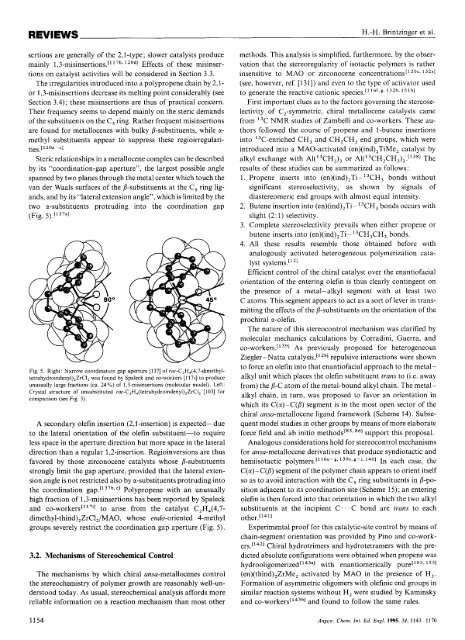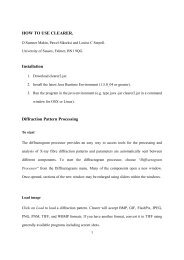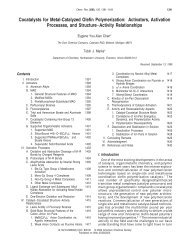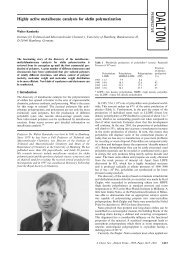Stereospecific Olefin Polymerization with Chiral Metallocene Catalysts
Stereospecific Olefin Polymerization with Chiral Metallocene Catalysts
Stereospecific Olefin Polymerization with Chiral Metallocene Catalysts
You also want an ePaper? Increase the reach of your titles
YUMPU automatically turns print PDFs into web optimized ePapers that Google loves.
REVIEWS<br />
sertions are generally of the 2,l-type; slower catalysts produce<br />
mainly 1,3-misinsertions.['' 7h* Effects of these misinsertions<br />
on catalyst activities will be considered in Section 3.3.<br />
The irregularities introduced into a polypropene chain by 2,lor<br />
1,3-misinsertions decrease its melting point considerably (see<br />
Section 3.4) ; these misinsertions are thus of practical concern.<br />
Their frequency seems to depend mainly on the steric demands<br />
of the substituents on the C, ring. Rather frequent misinsertions<br />
are found for metallocenes <strong>with</strong> bulky 8-substituents, while a-<br />
methyl substituents appear to suppress these regioirregularities.[l'Oa<br />
~ cl<br />
Steric relationships in a metallocene complex can be described<br />
by its "coordination-gap aperture", the largest possible angle<br />
spanned by two planes through the metal center which touch the<br />
van der Waals surfaces of the p-substituents at the C, ring lig-<br />
ands, and by its "lateral extension angle", which is limited by the<br />
two cr-substituents protruding into the coordination gap<br />
(Fig. 5).['37a1<br />
Fig. 5. Right: Narrow coordination gap aperture [137] of rac-C,H4(4,7-dimethy1-<br />
tetrahydroindenyl),ZrCI, was found by Spaleck and co-workers [117i] to produce<br />
unusually large fractions (cd. 24%) of 1,3-misinsertions (molecular model). Left:<br />
Crystal structure of unsubstituted rac-C,H,(tetrahydroindenyl),ZrCI, [ 1031 for<br />
comparison (see Fig. 3).<br />
A secondary olefin insertion (2,l -insertion) is expecteddue<br />
to the lateral orientation of the olefin substituent-to require<br />
less space in the aperture direction but more space in the lateral<br />
direction than a regular 1,2-insertion. Regioinversions are thus<br />
favored by those zirconocene catalysts whose b-substituents<br />
strongly limit the gap aperture, provided that the lateral extension<br />
angle is not restricted also by cr-substituents protruding into<br />
the coordination gap.['37b, Polypropene <strong>with</strong> an unusually<br />
high fraction of 1,3-misinsertions has been reported by Spaleck<br />
and co-worker~["~~~ to arise from the catalyst C,H4(4,7dimethyl-thind),ZrCl,/MAO,<br />
whose endo-oriented 4-methyl<br />
groups severely restrict the coordination gap aperture (Fig. 5).<br />
3.2. Mechanisms of Stereochemical Control<br />
The mechanisms by which chiral ansa-metallocenes control<br />
the stereochemistry of polymer growth are reasonably well-un-<br />
derstood today. As usual, stereochemical analysis affords more<br />
reliable information on a reaction mechanism than most other<br />
H.-H. Brintzinger et al.<br />
methods. This analysis is simplified, furthermore, by the observation<br />
that the stereoregularity of isotactic polymers is rather<br />
insensitive to MA0 or zirconocene concentrations[120c. 132a1<br />
(see, however, ref. [131]) and even to the type of activator used<br />
to generate the reactive cationic species.[' 16f,g, 132b3 151b1<br />
First important clues as to the factors governing the stereoselectivity<br />
of C,-symmetric, chiral metallocene catalysts came<br />
from I3C NMR studies of Zambelli and co-workers. These authors<br />
followed the course of propene and I-butene insertions<br />
into I3C-enriched CH, and CH,CH, end groups, which were<br />
introduced into a MAO-activated (en)(ind),TiMe, catalyst by<br />
alkyl exchange <strong>with</strong> Al("CH,), or A1('3CH,CH,)3.[1381 The<br />
results of these studies can be summarized as follows:<br />
Propene inserts into (en)(ind),Ti- 13CH, bonds <strong>with</strong>out<br />
significant stereoselectivity, as shown by signals of<br />
diastereomeric end groups <strong>with</strong> almost equal intensity.<br />
Butene insertion into (en)(ind),Ti- I3CH3 bonds occurs <strong>with</strong><br />
slight (2: 1) selectivity.<br />
Complete stereoselectivity prevails when either propene or<br />
butene inserts into (en)(ind),Ti- '3CH,CH, bonds.<br />
All these results resemble those obtained before <strong>with</strong><br />
analogously activated heterogeneous polymerization cata-<br />
lyst<br />
Efficient control of the chiral catalyst over the enantiofacial<br />
orientation of the entering olefin is thus clearly contingent on<br />
the presence of a metal-alkyl segment <strong>with</strong> at least two<br />
C atoms. This segment appears to act as a sort of lever in trans-<br />
mitting the effects of the P-substituents on the orientation of the<br />
prochiral cr-olefin.<br />
The nature of this stereocontrol mechanism was clarified by<br />
molecular mechanics calculations by Corradini, Guerra, and<br />
co-workers." 391 As previously proposed for heterogeneous<br />
Ziegler-Natta catalysis,['2b1 repulsive interactions were shown<br />
to force an olefin into that enantiofacial approach to the metal-<br />
alkyl unit which places the olefin substituent trans to (i.e. away<br />
from) the p-C atom of the metal-bound alkyl chain. The metal-<br />
alkyl chain, in turn, was proposed to favor an orientation in<br />
which its C(cr)-C(p) segment is in the most open sector of the<br />
chiral ansa-metallocene ligand framework (Scheme 14). Subse-<br />
quent model studies in other groups by means of more elaborate<br />
force field and ab initio method^[*^,^^^ support this proposal.<br />
Analogous considerations hold for stereocontrol mechanisms<br />
for ansa-metallocene derivatives that produce syndiotactic and<br />
hemiisotactic polymers,[' 16e-g. 13% 9-i. 1401 In each case, the<br />
C(cl)-C(p) segment of the polymer chain appears to orient itself<br />
so as to avoid interaction <strong>with</strong> the C, ring substituents in /?-PO-<br />
sition adjacent to its coordination site (Scheme IS); an entering<br />
olefin is then forced into that orientation in which the two alkyl<br />
substituents at the incipient C."C bond are trans to each<br />
other.[1411<br />
Experimental proof for this catalytic-site control by means of<br />
chain-segment orientation was provided by Pino and co-worker~.['~']<br />
<strong>Chiral</strong> hydrotrimers and hydrotetramers <strong>with</strong> the predicted<br />
absolute configurations were obtained when propene was<br />
hydro~ligomerized['~~~l <strong>with</strong> enantiomerically pure['03. 251<br />
(en)(thind),ZrMe, activated by MA0 in the presence of H,.<br />
Formation of asymmetric oligomers <strong>with</strong> olefinic end groups in<br />
similar reaction systems <strong>with</strong>out H, were studied by Kaminsky<br />
and co-~orkers['~~~] and found to follow the same rules.<br />
1154 Angrw. Chem. Ini. Ed. Engl. 1995, 34, 1143 ~ 1 170






